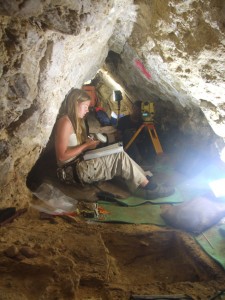
taking samples from archaeological excavations at the rear of a constricted cave passage in South Africa
To many researchers the word ‘Archaeomagnetism’ is synonymous with Archaeomagnetic dating. i.e. using small changes in the secular variation of the Earth’s magnetic field to date burnt structures and artefacts (see Neil’s post on the 16th February). However, this is just one of a range of studies that can use magnetic methods of analysis to reconstruct and understand archaeological deposits or artefacts. I am one of the few geomagnetists whose undergraduate background is in archaeology, rather than physics, geophysics or geology. As such, I consider myself as much an archaeologist as a geomagnetist and I believe passionately about multi-disciplinary work and interaction of researchers. I also believe that modern archaeology is a science conducted predominantly in the field or the laboratory and driven by rigorous scientific analysis and hypothesis testing. My interests are not primarily in understanding the origins of the Earth or how and why the magnetic field changes but how humans evolved both anatomically and behaviourally.
To try and gain a unique perspective on these issues I use magnetic methods of analysis to improve the chronological framework of human evolution, to reconstruct the early human use of fire and to reconstruct the palaeoclimate in which humans were living. Magnetism is an extremely versatile and underutilised resource in archaeology in that it can help archaeologists answer a range of different questions, if only they knew to ask, or if only geomagnetists knew that archaeologists wanted to know the answer to such questions. Done correctly, archaeomagnetism in its broadest sense can be a symbiotic relationship between the two disciplines where geomagnetists get answers about the behaviour of the Earth’s magnetic field through time and archaeologists learn, not only the age of their sites, but the heating temperature of their hearths and kilns; their atmosphere of heating or fuel source; whether campfires were used once or multiple times; if ancient humans heated their artefacts to change their properties for some purpose; and much much more. As with everything in life communication is the key. Ask not only ‘what can Archaeomagnetism tell us?’ but ask ‘can we solve this problem using Archaeomagnetism?’ and the answers might surprise you! ……..it always surprises me.

Leave a Reply